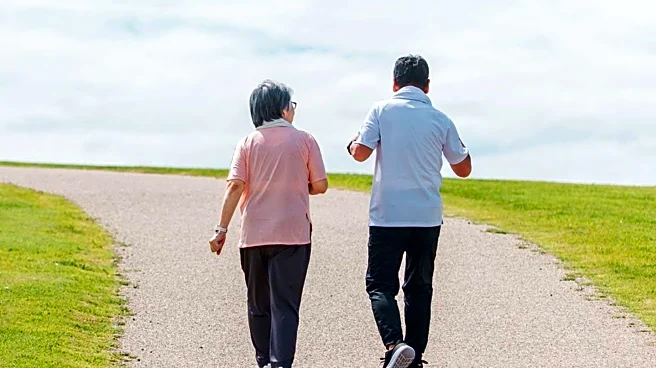What's Happening?
Walking has gained popularity as a form of exercise, with interval walking, known as 'Japanese walking,' becoming particularly trendy. This method involves alternating between regular and speed walking, and it originated from a 2007 study in Japan. The study found that high-intensity interval walking can protect middle-aged and older adults from increases in blood pressure and decreases in muscle strength. Recent studies have supported these findings, showing improvements in mobility and endurance among older adults who increase their walking pace. Personal trainers and health experts agree that walking is a beneficial form of exercise, offering various health benefits such as improved cardiovascular health, muscle endurance, and cognitive function.
Why It's Important?
Walking, especially interval walking, is significant as it provides a low-impact exercise option that can be easily integrated into daily routines. It offers substantial health benefits, including reducing the risk of cardiovascular disease, improving muscle strength, and enhancing cognitive function. This form of exercise is accessible to a wide range of people, including those who may not be able to engage in high-impact sports. The growing trend of walking, supported by studies and expert opinions, highlights its potential to improve public health outcomes, particularly for older adults who may face mobility challenges.
What's Next?
As walking continues to gain popularity, individuals may seek ways to enhance their walking routines, such as increasing duration, speed, or incorporating weights. Fitness apps and wearable technology can assist in tracking progress and setting goals. Community walking groups or clubs may also emerge, providing social support and motivation. Health professionals might further explore walking as a therapeutic intervention for various health conditions, promoting it as a preventive measure against chronic diseases.
Beyond the Headlines
The trend of walking, particularly interval walking, may influence broader cultural shifts towards more sustainable and accessible forms of exercise. It could lead to increased investment in public walking spaces and infrastructure, encouraging outdoor activities and community engagement. Additionally, the emphasis on walking may inspire innovations in fitness technology and apparel, catering to the growing demand for walking-related products.












